Mary Anne Yarde's Blog: The Coffee Pot Book Club , page 108
January 6, 2020
Join #HistoricalRomance author, Penny Hampson, as she takes a look at the reality of life as a child climbing boys in Regency England #History #Regency @penny_hampson
Climbing Boys: A Peek at the Reality of Life in Regency EnglandBy Penny Hampson
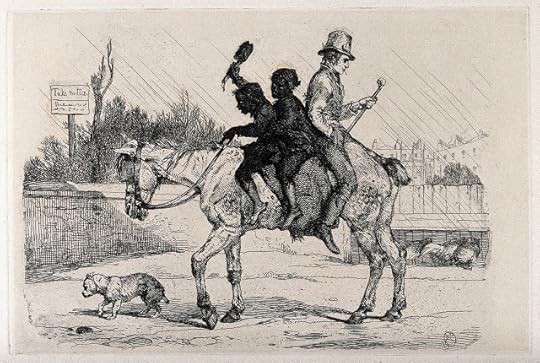
As a writer of historical fiction set in Regency England, I often describe scenes where my characters are warming themselves by an open fire, so I decided to look at how fireplaces and chimneys in those stately homes and inns were maintained in the past. Believe me, it wasn’t pleasant, and some of you may find the details upsetting.
From the late 17th century onwards, the number of brick built houses in towns rapidly grew. As a result of the Great Fire of London in 1666, a Government Act was brought in to regulate the construction of buildings, covering such things as the thickness of the brickwork, ceiling heights, etc. Coal, increasingly used as fuel instead of wood, required a good draught to burn efficiently and so fireplaces were designed with reduced sized flues. These narower flues became blocked more frequently if they were not swept regularly, leading to the danger of fire. Previously, older style flues, being wider, were not as difficult for a householder himself to clean, but these more modern, narrower flues posed a problem.
In England, Building Acts of 1774, 1834, and 1840, sought to diminish the risk of chimney fires by stipulating that chimneys should be regularly cleaned. Master sweeps were unable to negotiate the reduced sized flues themselves, so small boys, and sometimes girls, were employed to do the job.
The children themselves came from the poorest sections of society, from parents who were unable to provide for their families, or more often, from parish workhouses who wished to alleviate the burden of the Poor Rate on their parishioners. Life for children in the workhouse was pretty dreadful anyway; a survey of 1765 found that in one London workhouse out of 78 children admitted in one year 64 died. In another workhouse, not one child survived in fourteen years. As an inducement to take parish children, workhouses offered a payment to prospective employers looking for ‘apprentices’. Charles Dickens references this practice in Oliver Twist.
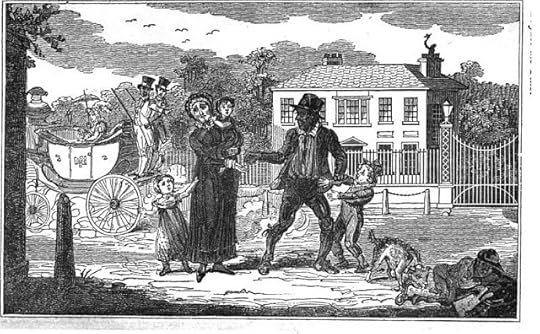 A widow selling her son to a chimney sweep.
A widow selling her son to a chimney sweep.Climbing boys were ‘apprenticed’ to chimney sweeps. Apprenticeship generally meant learning a recognised trade, so that on adulthood, the apprentice could become a tradesman in his own right. Unfortunately, this was not the case for climbing boys. If he managed to reach adulthood at all, a climbing boy would most likely be in ill-health, and deformed due to being forced into unnatural angles to negotiate the twisting, narrow flues. Elbows and knees became scarred and thickened by being constantly scraped against the brickwork; knees also suffered under the stress of carrying heavy bags of soot.
‘Short life is very common among them, frequently from their being exposed to colds, coughs, and from the poor and miserable and half-starved manner in which they generally live, as many of them are not allowed to eat anything, except what they obtain through the generosity of the inhabitants whose chimneys they sweep.’
Boys frequently got stuck, and were burned or suffocated while cleaning. In 1794, a boy was suffocated in a flue in Stradishall, Suffolk. In 1811 a boy in Wakefield was burned to death when he fell down a flue. In 1808, a boy got stuck in a chimney and had to be rescued by the house owner removing bricks to create an opening. When his master returned, the boy, who was weak and suffering from fatigue, was beaten and sent on his way to clean another chimney.
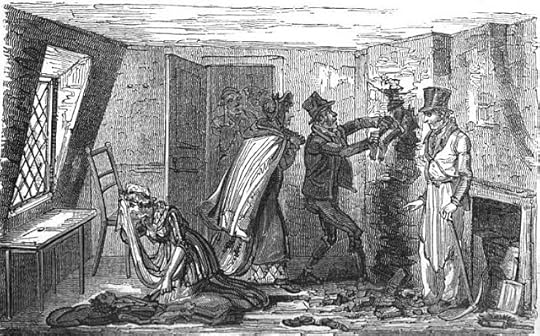
In 1813, another boy was not so lucky. Sent up a brewery chimney by his master, the eight-year-old did not return. A hole was made to pull him out, but he was already dead.
Cruelty by the master sweeps was not uncommon, the argument being that boys would not go up the chimneys otherwise. There are numerous reports of boys being beaten and starved. In February of 1808, a boy died of exposure after starting work at three in the morning. In a leaflet entitled An Appeal to the Humanity of the British Public, the deaths of six boys in 1816, and eight in 1818 were recorded. One was a boy of five years old, while another boy was ‘dug out - quite dead’ and ‘the most barbarous means were used to drag him down’
Another terrible consequence of being a climbing boy was Chimney sweeps’ carcinoma, a disease affecting the skin of the scrotum. This was the first reported form of occupational cancer, identified in 1775. A dreadful disease, the only known cure was the cutting away of the scrotum and sometimes the testicles; death could result from the disease itself or the surgery.
As early as 1773, there had been calls for action to alleviate the sufferings of the climbing boys, notably by one man, the philanthropist Jonas Hanway. His intervention brought about legislation in 1788, which ostensibly prohibited the use of boys under eight years of age.
But matters did not improve. In The Gentleman’s Magazine for November1802, the following appeal was published by someone signing himself as a ‘Friend to progress in Social life’:
‘Must a number of children be dwarfed and disfigured, and, what is worse, made the victims of brutal cruelty, who, if rescued from such a situation, might contribute to the strength of our navy, the culture of our fields, and thus repay, by important services, the benevolent invention which raised them to a place of honour in civil life… to climb, shivering and naked, a cold and dirty chimney, whilst their only reward is hard fare, and worse lodging. The master learns to be a tyrant, the boy acquires the disposition of a slave.’
Speaking of tyrants, the same edition of The Gentleman’s Magazine includes a vivid account of a well-known chimney sweep. Mrs Bridger, otherwise known as Mother Brownrigg, was reported as having died at her house in Swallow Street. On the morning of her death she had drunk a pint of gin, due to being low in spirits, because her foreman, Peter Cavanagh had been convicted and sentenced to six months imprisonment for the kidnap and cruel treatment of a child, and she was likely to face the same charges.
With the death of her partner ten months previously (in the article, doubt is cast on whether she was actually married to Mr Bridger) she had been constantly confined to bed by badly ulcerated legs, a result of her heavy drinking. She was reported to drink three or four ‘glasses of liquor’ before breakfast, and a couple of pints of beer. ‘The remainder of the day she spent in like manner.’ To visitors, she would complain of her low spirits whilst taking a drink from the bottle that ‘always stood by her bedside’.
It was reported that, for amusement, she would have one of her young apprentices brought to her, have him stripped naked, then she would beat him ‘in a most cruel and barbarous manner with a large stick’ kept by her bedside for that purpose. When she was in a good mood, she would force her apprentices to box each other, giving ‘a piece of plum pudding or a halfpenny to the victor.’
Her apprentices were forced to get up at three every morning and, barefooted and shirtless, made to sweep chimneys. Returning home, they were then required to scour the stairs, and undertake other menial household tasks before they received their meal.
After her death, her body was put on public display, ‘the neighbours and passengers wishing to see a monster, concerning whom they had heard much’.
The article describes her as ‘a disgrace to her sex and to humanity, as well as the torment and scourge of all who had the misfortune to have any connection with her.’
In 1817 the legislation banning the use of boys under eight years of age was still largely being ignored. It was reported that, though the majority of boys were between the ages of eight and fourteen, children of five and six were still being employed to clean small chimneys.
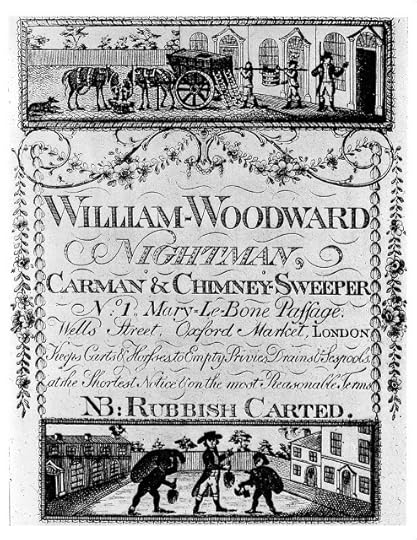
‘Little boys for small flues’ was a popular slogan used on chimney sweeps’ trade cards, to assure customers that they would be able to deal with the very small flues of ovens and coppers, which were usually less than nine inches square.
An account of 1819, tells of another unfortunate incident.‘the boy was employed in sweeping the library chimney; the boy went freely and voluntarily up the chimney, and knowing it to be a troublesome chimney, two boys went up at the same time; the little boy went out at the top of the chimney, the deceased was in the slanting part of the chimney and was … overpowered by the soot and suffocated. … a bricklayer was got and the chimney was broken into, where the boy was found, his head surrounded on all sides by the soot; he was suffocated and dead; … he was nearly an hour and a half in the chimney.’
If a boy got stuck and did manage to get out alive, he would not receive much sympathy from a master, more likely he would suffer a beating for causing trouble and embarrasment. The death of a boy would be hushed-up, with the boy’s body being brought out the house surreptitiously, and household staff warned not to mention it.
One of the worst jobs a climbing boy could be given, was to act as a ‘nightman’, that is, cleaning out privies. This was a task usually given to the smallest boy.
‘I have been tied round the middle and let down several Privies, for the purpose of fetching watches and things; it is generally made the practice to take the smallest boy and let him through the hole without taking up the seat, and to paddle about there till he finds it, they do not take a big boy because it disturbs the seat.’
Despite all the cruelties, deaths, and even the fact that mechanical sweeping machines, able to deal with the narower flues, had been in existence since 1803, legislation to ban the use of climbing boys continued to be defeated, notably in 1817, 1818, and 1819. It was only in 1875 that Lord Shaftesbury (1801-1885), philanthropist and social reformer, succeeded in introducing a Bill that was finally passed.
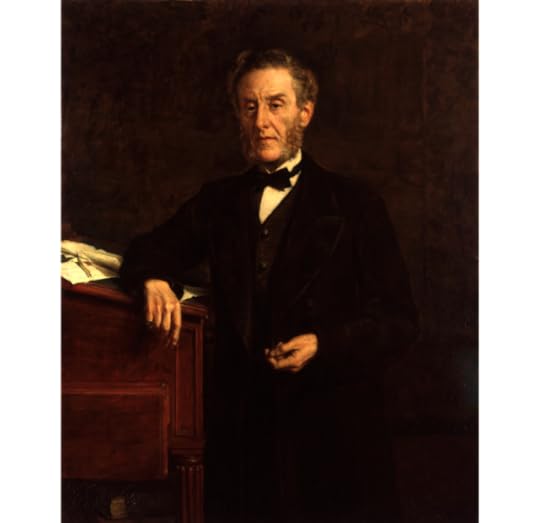 Lord Shaftesbury.
Lord Shaftesbury.So next time you read a story set in the past, where one of the characters leans casually against a mantelpiece, or someone warms themselves next to a blazing fire, spare a thought for the poor little mites who were forced to clean the chimneys, and be thankful that this terrible practice was brought to a halt.
An Officer’s VowBy Penny Hampson
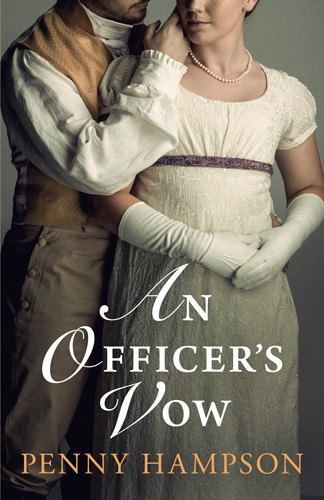
The future looks bleak to Major Nate Crawford. Depressed after being sent home from the Peninsular Campaign as unfit for service, he contemplates ending it all. Then an unexpected opportunity for adventure beckons in the shape of a delightfully intriguing runaway heiress. He will prove his worth as an officer and a gentleman by offering his help. He has a plan…
Lottie Benham is desperate. Her life is in danger and she needs a place of safety until her next birthday. The unexpected proposal from this attractive, but intimidating officer could be the answer to her prayers. Not normally a risk-taker, she decides to gamble all by placing her trust in this charismatic gentleman, who she suspects might be more in need of help than she.But the best laid plans…
Caught up in conflict, danger, and deception, will Lottie and Nate survive to find the perfect solution to their problems?
Amazon UK • Amazon US
Penny Hampson
 Having worked in various sectors before becoming a full time mum, Penny Hampson decided to follow her passion for history by studying with the Open University. She graduated with honours and went on to complete a post-graduate degree.
Having worked in various sectors before becoming a full time mum, Penny Hampson decided to follow her passion for history by studying with the Open University. She graduated with honours and went on to complete a post-graduate degree.Penny then landed her dream role, working in an environment where she was surrounded by rare books and historical manuscripts. Flash forward nineteen years, and the opportunity came along to indulge her other main passion – writing historical fiction. Encouraged by friends and family, three years later Penny published her debut novel A Gentleman’s Promise.
Penny lives with her family in Oxfordshire, and when she is not writing, she enjoys reading, walking, swimming, and the odd gin and tonic (not all at the same time).
Connect with Penny: Website • Twitter
SourcesThe Climbing Boys, A Study of Sweeps’ Apprentices, 1773-1875, K. H. Strange, 1982, Allison & BusbyThe Chimney-Sweeper’s Friend and the Climbing Boy’s Album, London, 1824Clamp, P. G. (1984). Climbing boys, childhood, and society in nineteenth-century england. The Journal of Psychohistory, 12(2), 193. Retrieved from https://ezproxy-prd.bodleian.ox.ac.uk... Britain, Parliament, Parliamentary Papers (Commons), 1817, vol. VI (Reports), Cmmd. 400, June 1817, ‘Report from the Committee on Employment of Boys in Sweeping of Chimnies: Together with the Minutes of Evidence Taken Before the Committee, and an Appendix, 23 June 1817.‘An Account of the Proceedings of the Society for Superseding the Necessity of Climbing Boys, 1816’ The Edinburgh Review LXIV (October 1819)Image of 2 boys on donkey https://wellcomecollection.org/works/gec86pkbTrade card for William Woodward, 18th century. Credit: Wellcome Collection. CC BY
Anthony Ashley-Cooper, 7th Earl of Shaftesbury by John Collier, National Portrait Gallery
Published on January 06, 2020 20:00
January 5, 2020
#BookReview — Eight Pointed Cross by Marthese Fenech #HistoricalFiction #Malta @Fenka33

Eight Pointed CrossBy Marthese Fenech

The violent clash between the Ottoman Empire and the Knights of St John on the island fortress of Malta serves as the backdrop to Eight-Pointed Cross. Young siblings Domenicus and Katrina Montesa live under constant threat of raids by the Ottoman Turks, the staunchest enemies of the Christian knights. All the while, hundreds of leagues away in Istanbul, Demir’s dream of becoming an imperial horseman in the Sultan’s cavalry is his only salvation against relentless torment by his cruel brother.
The Turkish invasion of Malta and the island’s bloody defence will forever change the lives of the three protagonists, whose fates are intertwined not only with each other, but with nobles and peasants, knights and corsairs, tyrants and galley slaves, on both sides of the conflict as the novel sweeps across the Mediterranean world of the sixteenth century – from Malta, a barren Christian outpost, to Istanbul, the glittering seat of Islam, from filthy prison cells to lush palace gardens.
Against soaring cliffs and open sea-lanes, the men and women of Eight-Pointed Cross face corruption and oppression, broken vows and betrayal, as two great empires collide. Surviving this battle-soaked world of swords and scimitars will test the limits of every character’s courage, loyalty, and love

“An army of one thousand sheep led by a lion is far more destructive than an army of one thousand lions led by a sheep. Suleiman the Magnificent led this attack—we faced an army of lions led by a lion.”
Domenicus Montesa would have preferred to have heard the story of how his mother and father met, but his sister Katrina adored her father’s stories of battles and warfare. Katrina’s one lament was that she had been born a girl and could never follow in her father’s footsteps and fight for the glorious Knights of St John.
For some, like Katrina’s father, Augustine, these Christian knights represented honour and nobility. But to others on the island of Malta, these knights were nothing more than Christian pirates who worshipped not God, but gold.
Thousands of miles away, in Istanbul, there was a young child who dreamed of two things. Firstly, Demir wanted to be an exceptional Muslim, and the second was that one day he wanted to become a Sipahi in the Sultan’s cavalry. But first, Demir had to survive the wrath of his father, Al Hajji Hamid al Azm, and the relentless torment of his elder brother. If he survived into adulthood, it would be a miracle, and if the secret that his mother hid ever come to light, his life would be over before it had begun.
With a lyrical narrative that is as rich in historical detail as it is in story and a prose that is poetically pleasing to the ear, Eight Pointed Cross by Marthese Fenech is the tautly gripping account of the clash of two great empires.
Eight Pointed Cross is astoundingly ambitious, but it is in all ways an absolute triumph. Fenech has penned not only a dazzling account of the Knights Hospitaller and what life was like in Malta during this time but also what it was like to grow up in Istanbul. And by writing this book in third person subjective, Fenech has assured that Eight Pointed Cross will definitely stand out in a crowded bookcase.
Fenech lavishly evokes the land in which her novel is set in, which gives this book not only authenticity but makes it unashamedly compelling. This historical detailing of this book has to be commended. Fenech has captured the very essences of this era while staying true to the period and the documented history. Fenech's depiction of the Knights of St. John is utterly sublime. With a keen eye on the history, Fenech also has a novelist intuition about what makes a book entertaining. Kudos, Ms Fenech. Kudos, indeed.
There are several protagonists in this book, and more than one antagonist. For most of this book, the Montesa’s family takes centre stage. When this novel begins, Domenicus and Katrina are children, by the end of this book they are adults. Watching them grow up in the pages of this book was a wonderful thing to behold. In the beginning, they think like children, but as their eyes are opened to the injustice and, in some cases, the cruelty of the world, they begin to see things differently to the way their father sees them. While Augustine seemingly accepts the way things are, Domenicus dares to question it. Whereas Katrina is determined to live the life that she wants to live and not the one that her sex demands of her.
Katrina is, without a doubt, one of my favourite characters in this book. She is so incredibly feisty and determined to do her own thing. However, as confident as she is, Katrina can also be blind to the obvious. Her faith in Franco di Bonfatti, a Knight of the Order, is absolute. Franco becomes a trusted friend who teaches Katrina to use a bow, but Katrina is completely oblivious to Franco’s growing, forbidden, attraction to her. I thought this naivety made Katrina incredibly human in the telling. On the other hand, Katrina’s relationship with Robert Falsone is tender and beautiful. I really enjoyed reading about Katrina. She is a wonderful heroine for readers to get behind.
Another fabulous heroine is Angelica. Angelica suffers a great loss at the beginning of this book, but she somehow rises above it and carries on with her life. Her relationship with Domenicus was depicted with great skill and care. I enjoyed reading about Angelica very much.
Demir is another one of the characters that I simply adored. He is this bright little boy who is smart, loving and, above everything else, kind. He is a complete contrast to his brother and his father. Demi suffers terrible abuse at their hands, and yet his strength of character is never toppled or shaken. He knows right from wrong, and he despairs at injustice, whether that be towards another human or an animal — a fabulous portrayal of a truly unforgettable character.
There are several antagonists in this book, from the corsairs to the Grand Master of the Knights. They are all, of course, products of their time and their beliefs, which made for a fascinating account. There is one character in particular who does not start out as an antagonist. I don’t want to give away any spoilers, so I am not going to name him, but his depiction was masterly drawn, and he really helped, in the latter part of this book, to drive the story forward.
There are many great historical fiction books, and Eight Pointed Cross by Marthese Fenech is one of them. Fenech is the ideal commentator for this story of empires, families, and war. This is a book where I found myself reaching for the Kleenex one moment and laughing out loud in the next. This is a book which made my heart-rate speed up as the heroes found themselves in increasingly desperate situations. This is a story that is filled with cliff-hanger tension and engrossing battle scenes. This is a story that horrifies, impresses and fascinates in almost equal measures. Eight Pointed Cross is a book of monumental scholarship. It is absolutely irresistible and one I could not put down.
If you are looking for your next great historical fiction read, then look no further than Eight Pointed Cross by Marthese Fenech — this book has it all, and then some.
I Highly Recommend.
Review by Mary Anne Yarde.The Coffee Pot Book Club.
Pick up your copy ofEight Pointed Cross
BDL Books
Marthese Fenech
 Marthese Fenech was born the youngest of five to Maltese parents in Toronto. She has traveled extensively across five continents, visiting sixty-five countries. Her research for her novels has taken her on numerous trips to Malta, Turkey, Italy, France, and Spain--a wealth of fascinating places that introduced her to her characters and their cultures in a most authentic way. She also spent time writing the trilogy while living in Singapore.
Marthese Fenech was born the youngest of five to Maltese parents in Toronto. She has traveled extensively across five continents, visiting sixty-five countries. Her research for her novels has taken her on numerous trips to Malta, Turkey, Italy, France, and Spain--a wealth of fascinating places that introduced her to her characters and their cultures in a most authentic way. She also spent time writing the trilogy while living in Singapore.When she was twelve and on a six-month stay in Malta, she enrolled in an all-girls private school run by nuns. She lasted three days before getting kicked out for talking too much. Back in Toronto, she started her own business recording, editing, and selling bootleg heavy metal concerts. She later worked with special needs children and adults, where witnessing small miracles on a daily basis was part of the job.
A former kickboxing instructor, Marthese has a Masters in Education and currently teaches high school English and history. She speaks fluent Maltese and French. As part of her research for Eight-Pointed Cross, she took up archery, and ended up accidentally becoming a certified instructor. She has a passion for adventure, photography, running, snowboarding, surfing, scuba-diving, climbing, and yoga.
Connect with Marthese: Website • Twitter • Facebook • Pinterest • LinkedIn • Goodreads.
Published on January 05, 2020 21:00
Join Historical Fiction author, Mercedes Rochelle, as she takes a look at Macbeth and the Gunpowder Plot #History #Macbeth #GunpowderPlot @authorrochelle
Macbeth and the Gunpowder Plot
By Mercedes Rochelle It wasn’t until recently that I discovered the link between Shakespeare’s famous play and the event that nearly shook England’s ruling class to its knees. The Gunpowder Plot was a carefully planned event with thirty-six barrels of gunpowder stashed under the House of Lords in order to blow King James and his government sky-high. Most fortunately—as the story goes—it was foiled by a last-minute letter to Lord Monteagle warning him not to attend Parliament the next day. A timely search of the basement exposed Guy Fawkes and his stockpile before he had the opportunity to apply the fuse. England celebrated its miraculous escape from disaster, and the king’s men went after the conspiracy with a vengeance.
 Gunpowder Plot Conspirators, Contemporary engraving, National Portrait Gallery, Source: Wikipedia.
Gunpowder Plot Conspirators, Contemporary engraving, National Portrait Gallery, Source: Wikipedia.
What did this have to do with Shakespeare? Well, as it turns out, Warwickshire was a hotbed of conspirators, and some properties near Stratford-Upon-Avon had been leased to provide a meeting house for the plotters. Worse than that, the town was full of closet Catholics known as recusants—and Shakespeare may have been one of them. A search of the properties in question revealed a hoard of forbidden Catholic paraphernalia—or “massing relics”, as they were called. William Shakespeare, unfortunately, was distantly related to some of the plotters themselves and had business relationships with others. Talk about guilt by association! Since we know next to nothing about Shakespeare, we can only speculate about his motivations. But I suspect appeasing the king might have been on his mind. Not so coincidentally, less than a year after the gunpowder plot we see the first performance of Macbeth, demonstrating the consequences of killing a king. Shakespeare also gives a nod to James’s lineage—Banquo was recognized as the ancestor to the Stewarts—as well as a reference to witches—a theme close to the monarch’s heart. It was commonly thought that diabolical agents were responsible for the most evil of human activities.
 Macbeth consulting the vision of the armed head, by Henry Fuseli. Source: Wikipedia.
Macbeth consulting the vision of the armed head, by Henry Fuseli. Source: Wikipedia.
But that’s not all. Renowned Shakespearean historian James Shapiro tells us that a discovery during the gunpowder plot investigation introduced a new word to the English lexicon: equivocation. Actually, the word wasn’t new; it was just redefined and “had become a byword that transfixed the nation and suffused the play he was writing”.1 The government badly needed a scapegoat—a leader—and they found him in the guise of Jesuit Superior Henry Garnet, who had written a treatise advising Catholics how to lie under oath during interrogation, while seeming to tell the truth. It was a play on words extraordinaire. A diligent search of the Inner Temple in London had uncovered this amazing manuscript, with a crossed-out title: “A Treatise of Equivocation” which had been changed to “A Treatise of Lying and Fraudulent Equivocation”. Here, too, the word “of” was crossed out and changed to “against”, but no one was fooled; the authorities had, in their hands, a how-to guide for evading prosecution. For example, “You could deny that you were harboring a priest by saying that the priest ‘lyeth not in my house,’ since he wasn’t telling lies there.”2 Whether the treatise had anything to do with the gunpowder plot was irrelevant; Garnet apparently knew about the conspiracy and kept silent. This was good enough, and so much better than prosecuting a handful of disgruntled Catholic gentry. Now the detested fingers of the Jesuits were all over the plot, and the treatise took on a major role in the legal proceedings. The word equivocation had gone viral, so to speak, and a high-profile trial of Garnet himself ended in the inevitable conviction of treason.
 Anonymous portrait of Friar Henry Garnet, Source: Wikipedia.In Macbeth, as Professor Shapiro tells us, “Equivocation permeates the play”. The witches equivocate when they tell Macbeth he shall be king—not informing him that he will need to kill in order to get the crown. And of course, later on, they equivocate, telling him he should never be vanquished ‘till Birnam Wood comes to Dunsinane. Macbeth equivocates to his wife, not telling her that Banquo’s heirs will be kings rather than his own. He equivocates when he kills the guards, then again when he hires Banquo’s murderers. Lady Macbeth equivocates when she tells the banquet guests that “my lord is often thus” after they watch him shriek at an empty chair. Even Lady McDuff equivocates, pretending to her son that his absent father is dead. But the most telling aspect of all is the porter scene, in which the word equivocate is used over and over again: “Knock, knock! Who’s there, in th’ other devil’s name? Faith, here’s an equivocator that could swear in both the scales against either scale, who committed treason enough for God’s sake yet could not equivocate to heaven. O, come in, equivocator.” The word is used five times by the porter and later, once by Macbeth. There’s no doubt that equivocation truly is the byword this time around, made even more interesting that it is only used once in all Shakespeare’s plays written before Macbeth. As he often did, Shakespeare wrote his play in response to concerns pervading London society. A fear of unseen forces was very real to his contemporaries, and Macbeth would have struck a chord in the unsettled atmosphere pervading King James’s court. One wonders what the playgoers might have thought when passing underneath the severed heads of the Gunpowder Plot conspirators, while crossing London Bridge from Southwark on their way home. 1 Shapiro, James, THE YEAR OF LEAR, SHAKESPEARE IN 1606, Simon & Schuster, New York, 2015, p.156
Anonymous portrait of Friar Henry Garnet, Source: Wikipedia.In Macbeth, as Professor Shapiro tells us, “Equivocation permeates the play”. The witches equivocate when they tell Macbeth he shall be king—not informing him that he will need to kill in order to get the crown. And of course, later on, they equivocate, telling him he should never be vanquished ‘till Birnam Wood comes to Dunsinane. Macbeth equivocates to his wife, not telling her that Banquo’s heirs will be kings rather than his own. He equivocates when he kills the guards, then again when he hires Banquo’s murderers. Lady Macbeth equivocates when she tells the banquet guests that “my lord is often thus” after they watch him shriek at an empty chair. Even Lady McDuff equivocates, pretending to her son that his absent father is dead. But the most telling aspect of all is the porter scene, in which the word equivocate is used over and over again: “Knock, knock! Who’s there, in th’ other devil’s name? Faith, here’s an equivocator that could swear in both the scales against either scale, who committed treason enough for God’s sake yet could not equivocate to heaven. O, come in, equivocator.” The word is used five times by the porter and later, once by Macbeth. There’s no doubt that equivocation truly is the byword this time around, made even more interesting that it is only used once in all Shakespeare’s plays written before Macbeth. As he often did, Shakespeare wrote his play in response to concerns pervading London society. A fear of unseen forces was very real to his contemporaries, and Macbeth would have struck a chord in the unsettled atmosphere pervading King James’s court. One wonders what the playgoers might have thought when passing underneath the severed heads of the Gunpowder Plot conspirators, while crossing London Bridge from Southwark on their way home. 1 Shapiro, James, THE YEAR OF LEAR, SHAKESPEARE IN 1606, Simon & Schuster, New York, 2015, p.1562 ibid, p.158
Excerpt from HEIR TO A PROPHECY

Chapter 1: AmbushFleance barely slowed his step as Banquo stopped again, removing a rock from his shoe. He and his father were already late to the king's banquet, and a half mile still stretched between them and the castle gate. It had seemed like a fine idea a couple of hours ago, taking a walk to get away from that hostile environment. There had been too many uncomfortable pauses in conversation, too many unfinished phrases, too many sideways glances. But now, dusk was quickly deepening into night, and it was getting difficult to see into the forest. There was probably a spy in every tree, for all he could tell.
The young man’s curly hair blew about his face as he looked up at the treetops. High cheekbones accentuated dark brown eyes as he raised his brows to see better through the shadows. His fine square chin gave him a profile he was proud of, and he went beardless, disregarding the current fashion. But his mouth, usually so prone to laughter, was pursed tonight in frustration.
"Blast this uphill climb," he grumbled as Banquo adjusted his cloak clasp. He glanced at his father wryly; this reticence was most unusual for him. His father grunted a response, but finally shifted his belt, shaking off his lethargy. Picking up their pace, father and son strode deep into the forest.
It was a quiet night, punctuated by the crunch of stones underfoot. Not a cricket was heard, nor birds, only the sigh of leaves rustling far overhead.
"It shall be rain tonight," Banquo said.
From behind came the cry: "Let it come down!"
In an instant, three dark forms were among them. Banquo was their main target, and two of them fell upon him, slashing the startled man in the face. The worthy lord was blinded by his own blood even as he shouted, "Villains, Murderers! Fly, Fleance, Fly!"
Though past his physical prime, the old warrior still was more than a match for both opponents. With a practiced motion, Banquo swept his sword from the scabbard, aiming an overhead cut at his nearest attacker's head. If the blow had hit, he would have cleaved the man's skull. But the blood was flowing so fast into his eyes that his aim was flawed. The blade only glanced off the other's shoulder, eliciting a howl of pain.
Enraged, the murderer dived at Banquo, catching him in the throat with a dagger. Letting go the knife, the man stepped back, clutching his arm; he was astounded that Banquo was still on his feet. For a moment, it seemed that their victim would respond with a last lunge. Then he staggered, gurgling, and collapsed into the arms of his murderers.
Fleance was already in motion before his father had shouted. Shoving his torch into the third assassin's face, he set the man's mask aflame. Screaming, clawing his face, the murderer went down, his feet kicked out from under him.
Fleance allowed himself a brief sneer. Then, wasting no more time, he moved toward the others when he saw the killers slashing Banquo's face. The boy hesitated, reluctant to abandon his father. But the assassins were too good at their work. Even from this distance he could tell that Banquo was already finished; his body gave no more sign of life.
It was also clear that their companion’s screaming made no impression on them; the assassins must have assumed that the victim was himself. Cursing, Fleance took advantage of the confusion. He stamped out his torch, kicked his assailant once more as the man was struggling up, and ran for his life.
Murder gave the forest a sinister cast. The trees seemed to bend their limbs before him, seeking to block his way. Fleance's breath came in short gasps, heightening the pain in his side as he ran frantically the way he had come.
His first thought was to go to Macbeth and raise a search party to ride down these outlaws. Then, a deeper, more telling conviction assailed him, though he knew not whence it came: perhaps the murderers were not there by chance. Perhaps they were paid assassins, in which case he could trust no one.
He considered, leaning against a tree and catching his breath. He wasn’t going anywhere without a horse, and both horses were still stabled at the castle. Going any closer to that accursed place was the last thing he wanted to do; however, he reminded himself that no one besides the assassins would know that there had been any trouble.It was a risk. Perhaps they would lie in wait for him near the stables and finish the job. But he had a feeling that they would be too busy tending their wounds. Despite himself, Fleance smiled grimly.
He looked slowly around the tree and up the path. Everything was quiet. He took one step then another, resisting the urge to break into a run. This was no time to panic. He needed to keep his senses about him. He looked one more time in all directions, then began striding quickly toward the castle, hand on his dagger.
No one stopped him at the castle gate and Fleance went directly to the stabler’s door. He knocked quickly then stepped back, looking around. There was no indication he was being followed yet.
The stabler took his time answering, his face breaking into a scowl when he recognized Fleance; he hadn’t expected anyone to leave for some hours yet. But when the youth held out a penny, his mouth curled into a greedy sneer and he quickly came out, making the coin disappear as he passed.
Fleance watched him go into the stable, resisting the urge to shout at the other to hurry up. The man seemed to take an inordinately long time, then he came out—alone."What about t’other?"
"I only need one now. Is he ready?"
The man shrugged. "Whatever you want." He opened the stable door and Fleance sighed with relief to see that his horse was saddled. Without another word he mounted, offering no explanation for his hasty conduct and rode off, leaving the man scratching his head.
Pick up your copy ofHEIR TO A PROPHECY Amazon UK • Amazon US
Mercedes Rochelle
 Mercedes Rochelle is an ardent lover of medieval history, and has channeled this interest into fiction writing. She believes that good Historical Fiction, or Faction as it's coming to be known, is an excellent way to introduce the subject to curious readers. Her first four books cover eleventh-century Britain and events surrounding the Norman Conquest of England. Her new project is called “The Plantagenet Legacy” and begins with the reign of Richard II. She also writes a blog: HistoricalBritainBlog.com to explore the history behind the story. Born in St. Louis, MO, she received by BA in Literature at the Univ. of Missouri St.Louis in 1979 then moved to New York in 1982 while in her mid-20s to "see the world". The search hasn't ended! Today she lives in Sergeantsville, NJ with her husband in a log home they had built themselves.Connect with Mercedes: Website • Blog • Facebook • Twitter.
Mercedes Rochelle is an ardent lover of medieval history, and has channeled this interest into fiction writing. She believes that good Historical Fiction, or Faction as it's coming to be known, is an excellent way to introduce the subject to curious readers. Her first four books cover eleventh-century Britain and events surrounding the Norman Conquest of England. Her new project is called “The Plantagenet Legacy” and begins with the reign of Richard II. She also writes a blog: HistoricalBritainBlog.com to explore the history behind the story. Born in St. Louis, MO, she received by BA in Literature at the Univ. of Missouri St.Louis in 1979 then moved to New York in 1982 while in her mid-20s to "see the world". The search hasn't ended! Today she lives in Sergeantsville, NJ with her husband in a log home they had built themselves.Connect with Mercedes: Website • Blog • Facebook • Twitter.
Published on January 05, 2020 20:00
January 2, 2020
Join author, Grace Augustine, as she takes a look back at the last 7 decades #History #HappyNewYear @mallidalli
A Brand New DecadeBy Grace Augustine
January 1stmarks the beginning of a new decade. Can you believe it? Some of us have been around long enough to see almost 7 decades! I know to others that is mind boggling but think of what has happened in these past 70 years.
Here in the U.S., The 1950’s brought us “The Baby Boom”, saw the beginning of the Korean War, gave us Charles Schultz’s comic strip Peanuts, J.D. Salinger’s The Catcher in the Rye, RCA colored televisions, and the first sighting of an UFO.

The 60’s was a time of upheaval in nearly all areas of America. Growing pains, riots, discriminations, the Vietnam War. There were sit-ins, love-ins, Woodstock. The Beatles and other British rock bands became overnight sensations in the USA. The death of our beloved President Kennedy.

So much happened in the 1970’s it’s hard to sum it all up. The Beatles broke up. The Ohio National Guard open fired on a peaceful demonstration at the campus of Kent State. Jimi Hendricks, Pablo Picasso, Jim Morrison of the Doors, and Janis Joplin die. Amtrak train service began at Union Station in Chicago. Walt Disney World officially opened. Arcade games were invented. Television program M*A*S*H began in 1972. HBO premiered as the first premium cable television channel. The New York World Trade Center’s Twin Towers were officially opened. There are so many other things that happened it would take pages to discuss.

The 1980’s: Shadowed by the Iran hostage crisis and ending with the symbolic fall of communism with the destruction of the Berlin Wall. There was a plethora of environmental, political and cultural events that shaped this decade. America was infatuated with the royal wedding of Prince Charles and Diana Spencer. We saw a mass exodus from Cuba, the volcanic eruption of Mt. St. Helen’s (and I was only 30 minutes away from it), CNN began broadcasting 24 hour news reporting, PacMan fever hit. The death of John Lennon rocked the country. Sandra Day O’Connor was the first woman appointed to the Supreme Court.

The 1990’s: The saga of President Bill Clinton and Monica Lewinski held television hostage. Kurt Cobain died. Wars break out all of the globe and the US becomes a major player in the wars in Iran, Iraq, and Afghanistan. Seinfeld was the iconic television program of the decade. Johnny Carson bid farewell to his time on The Tonight Show. Social media and internet were more widely used, as were cell phones.

The 2000’s: Stock market crashes, recession, financial scandals, anti-trust cases, and world-wide disasters plagued this decade. The Y2K scare took weeks to fix. Microsoft released Windows 2000, the bridge to XP. Intel releases the Pentium III processor. Apple releases OS X. Hewlett Packard and Compaq agree to a merger. The majority of this decade was internet/world wide web centered.

The 2010’s: Google leaves China. The launch of the iPhone4. Twitch, Spotify, and Netflix become household words. Steve Jobs dies. Facebook purchases Instagram. Adobe commits to the “cloud”. Edward Snowden reveals NSA’s PRISM project. The signing of the Paris Climate accord. Donald Trump is elected President of the U.S. Amazon buys Whole Foods. Wildfires rage in California. Spotify gets into Podcasting.

So, there you have it 7 decades of information. I don’t know about you, but I’m excited to see what 2020 brings.
Dalgaard Castle
By Grace Augustine

Dalgaard Castle stood proud among modern homes as a reminder of the battles of yesterday. Centuries ago, the bloodiest of wars between the Fire Dragon Guard and the Ice Dragons, who ruled Taydaryn, destroyed much land, homes, and lives—including the Queen’s husband, Amarice.
Brenna Dalgaard, the elder daughter of Queen Isara and King Consort Amarice, lived in two worlds. She loved her small Norwegian home, but also loved her thriving designer clothing business in Chicago. Brenna traveled home as much as her life would allow.
Tirdon, Assistant to the Prime Minister of Taydaryn, continues to support and uphold the laws of the kingdom and aide in any way possible. Amarice had faith in him to place him in this position with the command of keeping an eye on his elder daughter, Brenna.
Tirdon and Brenna have danced around each other their entire lives. A mis-fortunate accident brings the two closer than either thought possible. Will an ancient secret split them forever or bring their love for each other out of the shadows?
*Adult content. Not for ages under 18.
Pick up your copy ofDalgaard Castle Amazon
Grace Augustine
 Internationally known author, Grace Augustine, was born in Shelby, Montana and grew up in Cut Bank, Montana (dubbed as The Coldest Spot in the Nation). Her work career has taken her from title and abstracting to administrative assistant church work to co-owning a small town weekly newspaper to her current profession as a floral designer.
Internationally known author, Grace Augustine, was born in Shelby, Montana and grew up in Cut Bank, Montana (dubbed as The Coldest Spot in the Nation). Her work career has taken her from title and abstracting to administrative assistant church work to co-owning a small town weekly newspaper to her current profession as a floral designer.Grace thinks of herself as a "Jill" of most trades and is not afraid to learn new things. "If you can't learn something new each day, there's something wrong," she says.
The ideas for her Acorn Hills series stem from her growing up years as well as the issues she has had to overcome along the way. "I've developed a new romance category...for the over 50 crowd...I'm calling it the salt and pepper genre. My books deal with real life issues, overcoming adversity, maintaining a positive outlook, and so much more. Just because we are 50 yrs old or older doesn't mean that life stops. We all still want attention and affection and adventure! We want to experience all life has to offer. We use our age as wisdom to share with those around us. We are sexual, sensual, and sensible," Grace explains.
Augustine was diagnosed with Multiple Sclerosis in July of 2003. Her thoughts on that "It may slow me down, but if I can at all do it, I will. Sitting and feeling sorry for yourself isn't the answer...living your life with an open, joy-filled heart is."
Grace loves to hear from readers, you can find her: Website • Facebook • Edits With A Touch Of Grace • Twitter.
Published on January 02, 2020 21:00
#BookReview — Love Lost in Time: A Tale of Love, Death and Redemption by Cathie Dunn #HistoricalRomance #timeslip @cathiedunn
Love Lost in Time:A Tale of Love, Death and RedemptionBy Cathie Dunn
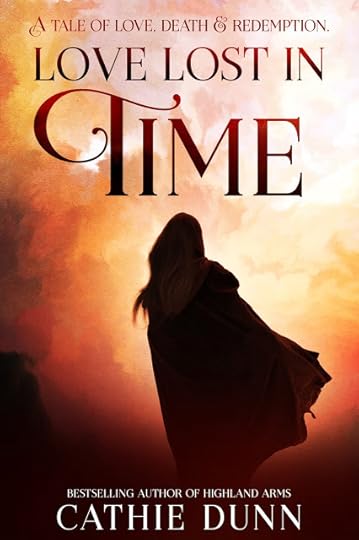
A tale of love, death and redemption…
AD 2018
Languedoc, south-west France
Madeleine Winters discovers ancient female bones under her kitchen floor. How did the woman end up buried, all alone, in that particular spot in the Cabardès hills?
And why was her back broken?
AD 777
Septimania, on the coast of the Mediterranean Sea
Seventeen-year-old Nanthild must marry Count Bellon of Carcassonne, a Visigoth, as part of his peace agreement with Charlemagne. As a wise-woman, she continues to visit those in need of her help during Bellon’s frequent absences.
But dangers lurk on her journeys…

"The sun. The forest. A faceless man. Earth. Darkness. Death. I have seen my death…"
In an increasingly Christian world, Lady Nanthild (Hilda), daughter of Milo, the Count of Vaulun, must be careful. If there were even a whispered rumour in the court of Charlemagne, that Hilda, like her late mother before her, was a wise-woman then her fate would be sealed, for the Christians preached that such women were in league with the Devil. But that was not the only thing that Hilda feared. Her beloved father has arranged for her to marry. Hilda could not deny that it was a good match. Lord Bellon, a Visigoth, would soon be named the new Count of Carcassonne, which would make Hilda a future Countess. However, Hilda knew next to nothing about her would-be husband, and she feared if Bellon ever found out about her healing gifts, he would not be merciful.
Madeleine Winters did not know just how devious her mother could be, until now. But there was no mistaking what the Notaire had said. If Madeleine wanted to inherit her mother's estate, then she had to stay in her mother's house in Languedoc, south-west France, for one year. Why did her mother insist on making her daughter's life an absolute misery, even after death? Madeleine's life was in York, England. However, her mother had left her with no choice. Madeleine would stay and renovate the house so she could sell it when the year was up.
As Madeleine began the arduous job of renovating her mother's house and make it appealing to the 21st Century property market, the oddest of things started to happen. First, it was the hint of lavender in the air, and then the building shook, and Madeleine was sure she could hear a woman's voice. This house, it seemed, had a secret and it was one it was desperate to share.
From the richness of Charlemagne's court and the regret of a daughter, as she stands over her mother's grave, to the realisation of an enemy and a skeleton under the kitchen floor, Love Lost in Time: A Tale of Love, Death and Redemption by Cathie Dunn is the unforgettable story that traverses two very different times.
With a keen sense of verse and a narrative that is as compelling as it is delectable, Love Lost in Time: A Tale of Love, Death and Redemption captured my imagination in the very first chapter and swept me away into a world of war, love, death, loss, and eventually peace and acceptance. This is a story of two especially strong women who are connected through time and place. It is a tale of two very different worlds with different values. It is a story that is difficult to put down and one that is impossible to forget.
Oh, this book had all the feels. It is, on the one hand, a fabulous modern-day paranormal story set in beautiful Languedoc. It is also an account of one very noble husband and wife, whose loyalty to Charles the Great was indisputable, and their commitment to each other was absolute. Love Lost in Time: A Tale of Love, Death and Redemption made me laugh, and it made me cry. It made me gasp with horror, and it made me smile with pleasure. Dunn has penned a very bold and ambitious book, and yet, she has scrumptiously balanced the two eras and made both periods utterly compelling.
Dunn has captured the essence of what it must have been like in Charlemagne's kingdoms during this time. Dunn's attention to the historical detail has to be commended. The historical setting in this book has been meticulously researched — it really felt like I had been transported back to the 8th Century. Likewise, modern-day France has also been elegantly depicted. Writing with this level of authority gave this book not only a great deal of elegance but also integrity.
Dunn has penned two remarkable heroines. I adored them both. Hilda is a woman of her time, but she is also a very intelligent, very caring lady who is gifted in the art of healing. Hilda also has a shrewd head when it comes to politics. Thankfully, Hilda is fortunate in her husband, and he allows her more freedom, in both her opinions and actions, than other men of the era would. Bellon and Hilda's romance is very sweet, very romantic. I can understand why Hilda falls for him as hard as she does. Their relationship was beautiful to behold, and one I very much enjoyed reading about.
Likewise, I thought Madeleine was fabulously portrayed. Her journey to finding out who she is, who her father was, and where she actually came from was fascinating, and her budding romantic relationship with Léon Cabrol also kept me enthralled. Madeleine's connection with the ghostly presence was not of the terrifying kind, but it was instead, one soul trying to help the other find peace. I thought the narrative for this was particularly beautiful and very well thought-out and executed. Kudos, Ms Dunn.
Dunn has composed a really rather wonderful book, and it is undoubtedly one that a reader can happily lose themselves in for a couple of hours. Love Lost in Time: A Tale of Love, Death and Redemption is a real treat for lovers of quality time-slip fiction.
I Highly Recommend.
Review by Mary Anne Yarde.The Coffee Pot Book Club.
Pick up your copy ofLove Lost in TimeAmazon UK • Amazon US
Cathie Dunn
 Cathie writes historical fiction & romance.
Cathie writes historical fiction & romance.On and off, she’s been writing for over twenty years. In 2008/09, she took courses online in Creative Writing at Lancaster University, with a focus on novel writing, which she now teaches in south-west France. She loves researching for her stories, delving into history books and visiting castles and historic sites.
Cathie is currently working on two novels: the sequel to Dark Deceit; and the first case in the Loup de Foix Mysteries, a series of historical murder mysteries set in the early 13th century around Carcassonne in south-west France. Her books have garnered praise from reviewers and readers for their authentic description of the past.
After many years in Scotland, Cathie now lives in south-west France with her husband, two cats and a dog.
Connect with Cathie: Facebook • Facebook Author Page • Twitter • Instagram.
Published on January 02, 2020 20:00
January 1, 2020
#HistoricalFiction author, Judith Arnopp, is taking a look at Life in the Time of Mary Tudor @JudithArnopp
Life in the Time of Mary TudorBy Judith Arnopp

I’ve written about many prominent Tudor women and the obstacles they faced. Margaret Beaufort lived a long and challenging life, battling her way through, and ultimately winning, the war of the roses to become the most powerful woman in the realm. Elizabeth of York showed great resilience in the face of adversity; Catherine of Aragon possessed enormous courage, Anne Boleyn bore herself with intelligence and wit, Katheryn Parr was dutiful, educated and wise. They were all admirable and history has at last come to recognise the part they played. The only woman I have written of so far who is not yet afforded this respect is Mary Tudor, and Mary is the one for whom I feel the most pity. In her infancy, Mary was the ‘pearl’ of her father’s world but once he sought a divorce and Catherine and Mary refused to play the king’s game, she fell from favour. Labelled a bastard, forced to serve her infant half-sister, Elizabeth, Mary’s story deteriorates into a dark fairy tale. But Mary had no fairy godmother. She had to fight single handed for everything she held dear: her title, her mother’s reputation, her position, her religion – and ultimately her kingdom. Fighting can make a person defensive and edgy and desperate for love and Mary was no exception.She longed for her father’s approval but although she was eventually welcomed back to court via the intervention of her stepmothers, Jane Seymour and later Katherine Parr, she never again reached the ‘adored’ status of her infancy. The friendliness of the courtiers ebbed and flowed around Mary governed by the tide of the king’s favour. She lived a life of uncertainty on a knife edge of fear.Reading between the lines of history, I feel Mary never forgave herself for agreeing, under unbearable pressure, that her parent’s marriage was illegal, branding herself illegitimate. The break-up between Henry and Catherine was the scandal of Europe, the gossip of the taverns. Wherever she went she would have heard, or at least imagined, whispers against her. Notoriety is difficult in any circumstances but Mary’s private life was bandied about the world. Steeped in unhappiness, her later paranoia becomes more understandable.

Even after Henry’s death, Mary was afforded little peace. She may have imagined she’d be allowed to retire to the vast properties left to her by her father but instead she was continuously pressured into adhering to Edward VI’s strictly Protestant laws. Mass was forbidden, the carrying of rosaries was prohibited yet Mary was defiant and refused to listen. She risk arrest and imprisonment by brazenly flouting the law and her brother’s authority. Edward was a young man and Mary had no reason to believe his rule would not be long; in all likelihood he would marry and have many heirs. She had no hope or expectation of ever becoming queen. Her future in Protestant England must have seemed bleak yet she fought on with no support for what she saw as right.On his death, with the crown waiting to fall into her hands, Mary’s future at last seemed rosy; she must have imagined a grand coronation, the people of England finally able to turn back to the true church but Mary reckoned without the dishonest schemes of John Dudley.Several months earlier, Dudley, Duke of Northumberland, had arranged a marriage between his eldest son and Mary’s cousin, Lady Jane Grey and then persuaded King Edward to name Jane heir in Mary’s stead. Just when Mary thought her trials were over, she was faced with the greatest battle of all – the fight for her throne.Mary’s reign is now regarded as a failure. She married against the will of the people. She failed to understand the desire of the people to worship in the manner in which they chose. She failed to provide an heir, suffering phantom pregnancies and dying before her innovative plans for England came to fruition. Yet some of those plans were promising. She began many policies that have since been laid at Elizabeth’s door; reforms to the economy, naval expansion, and colonial exploration and had her reign been longer, she may have been remembered very differently. As with her father, Mary is remembered for her worst very acts yet there was much more to her than religious persecution and brutality.Overall, Mary was a kind woman, generous, effusive and motherly to those closest to her. It was only the question of religion that brought out her intractable side. For Mary, matters of faith were black and white. As far as she was concerned, to argue against Catholic tradition was to argue against God. There was just one true church; one way of doing things. Her father’s break with Rome was as emotionally damaging to Mary as his break from her mother. She feared for his soul and she feared for the souls of the English subjects who followed his lead. Her fight against heresy was not a matter of cruelty or vindictiveness. She did not grudge Protestants in the way that you grudge someone from an opposing football team. Once she was queen, the Protestants of England were as much her subjects as the Catholics and she feared for their immortal souls. She saw it as her duty to lead them away from sin. The burning of heretics was standard punishment and to Mary, doomed as heretics were to burn in hellfire, it served as a deterrent.From childhood, Mary was isolated and usually out of royal favour. Her nebulous status made her unmarriageable so her fertile years were over by the time she made the disastrous marriage with Philip of Spain. She had no equals, and apart from her most loyal servants, no real friends. She died knowing she had failed. In the company of her favoured servants her last days were spent in great pain, almost completely blind, and tortured by the necessity of leaving her beloved subjects in the hands of her Protestant sister, Elizabeth.
The Heretic Wind:
The Life of Mary Tudor, Queen of England
By Judith Arnopp
 Adored by her parents and pampered by the court, the infant Princess Mary’s life changes suddenly and drastically when her father’s eye is taken by the enigmatic Anne Boleyn.
Adored by her parents and pampered by the court, the infant Princess Mary’s life changes suddenly and drastically when her father’s eye is taken by the enigmatic Anne Boleyn.Mary stands firm against her father’s determination to destroy both her mother’s reputation, and the Catholic church. It is a battle that will last throughout both her father’s and her brother’s reign, until, she is almost broken by persecution. When King Edward falls ill and dies Mary expects to be crowned queen.
But she has reckoned without John Dudley, the Duke of Northumberland, who before Mary can act, usurps her crown and places it on the head of her Protestant cousin, Lady Jane Grey.
Furious and determined not to be beaten, Mary musters a vast army at Framlingham Castle; a force so strong that Jane Grey’s supporters crumble in the face of it, and Mary is at last crowned Queen of England.
But her troubles are only just beginning. Rebellion and heresy take their toll both on Mary’s health, and on the English people. Suspecting she is fatally ill, and desperate to save her people from heresy, Mary steps up her campaign to compel her subjects to turn back to the Catholic faith.
All who resist will face punishment for heresy in the flames of the Smithfield fires.
The Heretic Wind: the life of Mary Tudor, Queen of England will be released on January 27th 2020. The Kindle version is available for pre-order now and paperback and audiobook will follow.

Pre-order your copy TODAY!AmazonReleased 27th January
Judith Arnopp
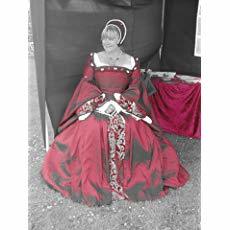 Judith Arnopp writes historical fiction set mainly in the late medieval and Tudor period. Her work includes:The Heretic Wind: the story of Mary Tudor, Queen of EnglandSisters of Arden: on the Pilgrimage of GraceThe Beaufort Chronicles: the life of Lady Margaret Beaufort (three book series)A Song of Sixpence: the story of Elizabeth of YorkThe Kiss of the Concubine: a story of Anne BoleynThe Winchester Goose: at the court of Henry VIIIIntractable Heart: the life of Katherine ParrThe Song of HeleddThe Forest DwellersPeaceweaver
Judith Arnopp writes historical fiction set mainly in the late medieval and Tudor period. Her work includes:The Heretic Wind: the story of Mary Tudor, Queen of EnglandSisters of Arden: on the Pilgrimage of GraceThe Beaufort Chronicles: the life of Lady Margaret Beaufort (three book series)A Song of Sixpence: the story of Elizabeth of YorkThe Kiss of the Concubine: a story of Anne BoleynThe Winchester Goose: at the court of Henry VIIIIntractable Heart: the life of Katherine ParrThe Song of HeleddThe Forest DwellersPeaceweaverConnect with Judith: Facebook • Twitter • Website • Blog.
Published on January 01, 2020 21:00
#BookReview — The Broken Man by Hawkings Austin #HistoricalFantasy

The Broken ManBy Hawkings Austin
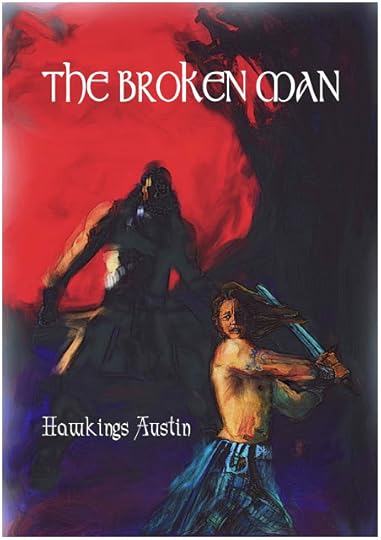
A Shadow Man is stalking the children of Ard, leaving the dead lying in the forest with their eyes black pits. The people are in a panic, but the investigating Ruad philosophers have no explanation. Seeking someone to blame, the people of the ancient city of Ard demand the head of the most dangerous person in their midst, the giant Waylaid.
Once great among the Fomor—a prince, a sorcerer, a priest, Waylaid has been cast out by his people. He has come to Ard with his Bolg apprentice, Piju, to live quietly and study in Brea’s library. Can he escape the maddened crowed and find the killer without breaking his vow to give up sorcery?
And has he failed to teach his young and impetuous apprentice the most important lesson of them all, that the price of using sorcery is always too high?

"Some nights the shadows just seem too dark..."
It did not matter if Cail, King of the Ruad, believed in spirits or not. The truth was that something sinister was killing the children of Ruad, and there was nothing that Cail could do to stop it.
While King Cail dithered, his people cast their eyes towards the Fomor giant, Waylaid and his young Bolg apprentice, Piju. If this were dark sorcery, then the Fomor was the obvious culprit. But, Waylaid and Piju were under the protection of The Judge of the Daen, and if the people of Ard dared to give in to their anger they would face the wrath of the Blessed Folk, and that was something no wise man wanted to do for the Blessed Folk were born for war.
Ironically, if anyone is to stop these mystery killings, then it would be Waylaid, who unbeknownst to most is the outcast Prince of Fodor. However, Waylaid made a vow never to use his sorcery again. The question is, will Wayliad be able to keep his vow and stop The Shadow Man from taking any more lives? Only time will tell...
From a beautiful spring morning in the land of Pwyer to the desperate battle to defeat a deadly shadow, The Broken Man by Hawkings Austin, is what historical fantasy is all about.
With an intricate plot and a narrative that is as lucid as it is compelling, The Broken Man is the kind of book which gets lovers of historical fantasy very excited. The atmospheric world that Austin has crafted is not only incredibly well-drawn but more importantly, utterly believable. Readers will love the political intrigue and the complex relationships between the different races of people that inhabit this world. The complicated class structure was also elegantly illustrated within the pages of this remarkable book. The City of Ard, where the tension between the Ruad and the enslaved Bolg was depicted with so much care and attention, came to life in all its glory and desperation — depending of course, on which faction Austin was writing about. I felt the abject poverty of the Bolg, and the nervousness of the nobles, who despite being seemingly safe with their considerable wealth, had no defences against a supernatural being. The splendour and the majesty of the Blessed Folk were clearly depicted and mighty to behold.
There are several fascinating protagonists in this story, but my favourite was definitely the wild Bolg, Piju. Piju is a sixteen-year-old hunter whose backstory is terribly tragic. He ends up apprenticed to Waylaid in a moment of unfortunate desperation, and yet, despite Piju's initial reservation, the two of them get on well. Piju is the only free Bolg in the City of Ard, and he will do anything to help his people, but he also has to be careful not to be recognised by the Ruad. When Piju discovers what is happening to the children of the Ruad, he immediately wants to help in any way he can. Piju is a sincere young man who fears the supernatural and his own power of prophecy, but he is very honourable. I liked Piju very much.
Another protagonist that caught my attention was Mistress Brea, Judge of the Daen. Mistress Brea is a very enigmatic character, she radiates power and confidence, but under the facade is a woman who has lost her husband to warfare and will one day face her sons in battle. In matters of war, Mistress Brea is formidable, but she is also an extraordinary judge and diplomat. I thought Mistress Brea's depiction was really rather wonderful.
Waylaid, who is the hero of this tale, is a very complex character. His past is incredibly moving — he is betrayed by someone very close to him, and the life he should have lived has been denied him. Waylaid is a character that keeps his thoughts and his true nature very close to his chest. He does not want to talk about who he was and what had happened. He is, despite being a very enigmatic character, very learned and wise. He has a good relationship with Mistress Brea — there is certainly mutual respect between these two characters, and he gets on well with his young apprentice. He and Piju are two souls who have lost everything, but they find a semblance of normality, a sense of belonging, with each other. Austin has crafted a very believable protagonist in Waylaid.
The paranormal aspect of this story has been well thought out and is, at times, incredibly chilling. The Shadow Man is a dangerous being who feeds on the souls of the innocent, and he is seemingly unstoppable. He is undoubtedly a very formidable antagonist.
There are several flashbacks in this book, which Austin uses to great effect to give the reader a balanced view of some of the characters. I thought this approach worked really well and was certainly insightful.
Austin writes with a compelling style. The Broken Man is quite a long book, but the time just flew by as I lost myself in the world that Austin has created. I thoroughly enjoyed every minute of it. Fans of historical fantasy will fall in love with this book and these characters.
I Highly Recommend.
Review by Mary Anne Yarde.The Coffee Pot Book Club.
Pick up your copy ofThe Broken ManAmazon UK • Amazon US
Published on January 01, 2020 20:00
December 31, 2019
Writing, Knights, and Chasing Dreams — a look back on 2019 #amwriting #blogging
Alden du Lac, once king of Cerniw, has nothing. Betrayed by Cerdic, Alden’s kingdom lies in rubble, his fort razed to the ground and his brother Merton missing, presumably dead. He has only one possession left worth saving: his heart. And to the horror of his few remaining allies, he gives that to the daughter of his enemy. They see Annis, at best, as a bargaining chip to avoid war with her powerful father. At worst, they see a Saxon whore with her claws in a broken, wounded king.
Alden has one hope: When you war with one du Lac, you war with them all. His brother Budic, King of Brittany, could offer the deposed young king sanctuary—but whether he will offer the same courtesy to Annis is far less certain.
Amazon
The Du Lac Devil(The Du Lac Chronicles, #2)
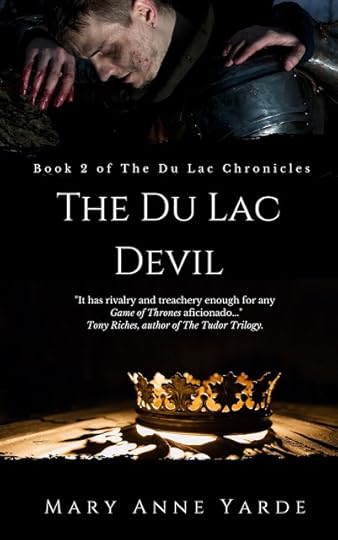
War is coming.
As one kingdom after another falls to the savage might of the High King, Cerdic of Wessex, only one family dares to stand up to him — The Du Lacs.
Budic and Alden Du Lac are barely speaking to each other, and Merton is a mercenary, fighting for the highest bidder. If Wessex hears of the brothers’ discord, then all is lost.
Fate brings Merton du Lac back to the ancestral lands of his forefathers, and he finds his country on the brink of civil war. But there is worse to come, for his father’s old enemy has infiltrated the court of Benwick. Now, more than ever, the Du Lac must come together to save the kingdom and themselves.
Can old rivalries and resentments be overcome in time to stop a war?
Amazon
The Du Lac Princess(The Du Lac Chronicles, #3)

The ink has dried on a Amandine's death warrant. Her crime? She is a du Lac.
All that stands in the way of a grisly death on a pyre is the King of Brittany. However, King Philippe is a fickle friend, and if her death is profitable to him, then she has no doubt that he would light the pyre himself.
Alan, the only man Amandine trusts, has a secret and must make an impossible choice, which could have far-reaching consequences — not only for Amandine, but for the whole of Briton.
Amazon
The Du Lac Prophecy(The Du Lac Chronicles, #4)

Two Prophesies. Two Noble Households. One Throne.
Distrust and greed threaten to destroy the House of du Lac. Mordred Pendragon strengthens his hold on Brittany and the surrounding kingdoms while Alan, Mordred’s cousin, embarks on a desperate quest to find Arthur’s lost knights. Without the knights and the relics they hold in trust, they cannot defeat Arthur’s only son – but finding the knights is only half of the battle. Convincing them to fight on the side of the Du Lac’s, their sworn enemy, will not be easy.
If Alden, King of Cerniw, cannot bring unity there will be no need for Arthur’s knights. With Budic threatening to invade Alden’s Kingdom, Merton putting love before duty, and Garren disappearing to goodness knows where, what hope does Alden have? If Alden cannot get his House in order, Mordred will destroy them all.
Amazon
All that is left for me to say is that I hope you have a happy and a successful year, and once again thank you. Thank you from the bottom of my heart.
All the best,
Mary Anne xxx
Mary Anne Yarde
 Mary Anne Yarde is the multi award-winning author of the International Bestselling Series — The Du Lac Chronicles. Set a generation after the fall of King Arthur, The Du Lac Chronicles takes you on a journey through Dark Age Britain and Brittany, where you will meet new friends and terrifying foes. Based on legends and historical fact, The Du Lac Chronicles is a series not to be missed.
Mary Anne Yarde is the multi award-winning author of the International Bestselling Series — The Du Lac Chronicles. Set a generation after the fall of King Arthur, The Du Lac Chronicles takes you on a journey through Dark Age Britain and Brittany, where you will meet new friends and terrifying foes. Based on legends and historical fact, The Du Lac Chronicles is a series not to be missed.Mary Anne is the founder of The Coffee Pot Book Club. She has been a professional reader since 2016 and in this time Mary Anne has reviewed many books for the big and small publishing houses, as well as books penned by her fellow indie authors. Mary Anne is also an editorial reviewer for The Coffee Pot Book Club. Mary Anne has been a judge for a prestigious Historical Fiction Book Award for the last three years, as well as being a Top Reviewer on Netgalley.
Born in Bath, England, Mary Anne Yarde grew up in the southwest of England, surrounded and influenced by centuries of history and mythology. Glastonbury — the fabled Isle of Avalon — was a mere fifteen-minute drive from her home, and tales of King Arthur and his knights were part of her childhood.
You can contact Mary Anne by email:
author@maryanneyarde.com
If you would prefer to chat on social media, then you can find Mary Anne on Twitter and Facebook.

Published on December 31, 2019 19:00
December 30, 2019
A Wintery Tempest — The Sparrow's Tale by Mary Anne Yarde #Christmas #DarkAges
 A Wintery Tempest:
A Wintery Tempest:The Sparrow's TaleBy Mary Anne Yarde

“The present life of man upon earth, O King, seems to me in comparison with that time which is unknown to us like the swift flight of a sparrow through the mead-hall where you sit at supper in winter, with your Ealdormen and thanes, while the fire blazes in the midst and the hall is warmed, but the wintry storms of rain or snow are raging abroad. The sparrow, flying in at one door and immediately out at another, whilst he is within, is safe from the wintry tempest, but after a short space of fair weather, he immediately vanishes out of your sight, passing from winter to winter again. So this life of man appears for a little while, but of what is to follow or what went before we know nothing at all.”
Bede — Ecclesiastical History of the English People
The Venerable Bede penned the Ecclesiastical History of the English People around AD 731. One of my favourite passages in the Ecclesiastical History is this passage about the sparrow. It is a very moving, a very humbling take on life. It is also one that has inspired many, including Michael Hirst's fabulous The Tudors series. I wonder if Bede knew that we would still be talking about his book and this passage over a thousand years later. But of course, as it is with the life of man, he would have had no idea about what was to follow.
Trevor Morris - "Time Of Which We Have No Knowledge" taken from The Tudors, narrated by Jonathan Rhys Meyers.
So, what might that sparrow have seen as he flew through that mead-hall on a cold wintery night?
Would he have seen and felt the warmth of the fire in the fire pit? Perhaps. He would have witnessed the nobles gathered around, drinking mead, ale, wine or beer. He would have seen a feast fit for any noble king. He probably saw dry-cured hams, venison, roasted goose and partridge, perhaps even a boars head — the tables groaning under the weight of the food. He would have seen cheese, and eggs — preserved ones — because all birds, even little sparrows, know that chickens tend to stop laying during the winter months. Warm pastries that crumbled in the mouth. So much appetising food and so plentiful, but such things did not tempt the sparrow to stay.
Maybe it was the music that scared the sparrow off, or perhaps the laughter. But I think it was one clear voice as it rung out as everyone else stared in silence as the bard told a story so profound that it drew tears in some and inspired others to be better than they have ever aspired to be. Such things held no interest to a little winter sparrow.
So much to see in that one unforgettable flight. But the call of the wild is too great to linger in such a hall, and the cold night of winter beckons the bird to find its own home in the woods where the snow falls ever so softly and man has no care to tread.
References:Bede — Ecclesiastical History of the English People (Bloomsbury Publishing Plc, 2012)
Head back to the Dark Ages with Mary Anne Yarde’s International Bestselling and Multi Award-Winning Series.

Read for FREE withKindle Unlimited.Amazon UK • Amazon US
Mary Anne Yarde
 Mary Anne Yarde is the multi award-winning author of the International Bestselling Series — The Du Lac Chronicles. Set a generation after the fall of King Arthur, The Du Lac Chronicles takes you on a journey through Dark Age Britain and Brittany, where you will meet new friends and terrifying foes. Based on legends and historical fact, The Du Lac Chronicles is a series not to be missed.
Mary Anne Yarde is the multi award-winning author of the International Bestselling Series — The Du Lac Chronicles. Set a generation after the fall of King Arthur, The Du Lac Chronicles takes you on a journey through Dark Age Britain and Brittany, where you will meet new friends and terrifying foes. Based on legends and historical fact, The Du Lac Chronicles is a series not to be missed.Mary Anne is the founder of The Coffee Pot Book Club. She has been a professional reader since 2016 and in this time Mary Anne has reviewed many books for the big and small publishing houses, as well as books penned by her fellow indie authors. Mary Anne is also an editorial reviewer for The Coffee Pot Book Club. Mary Anne has been a judge for a prestigious Historical Fiction Book Award for the last three years, as well as being a Top Reviewer on Netgalley.
Born in Bath, England, Mary Anne Yarde grew up in the southwest of England, surrounded and influenced by centuries of history and mythology. Glastonbury — the fabled Isle of Avalon — was a mere fifteen-minute drive from her home, and tales of King Arthur and his knights were part of her childhood.
You can contact Mary Anne by email:
author@maryanneyarde.com
If you would prefer to chat on social media, then you can find Mary Anne on Twitter and Facebook.
Published on December 30, 2019 20:00
December 29, 2019
Historical Fiction author, Vivienne Brereton, is taking a look at Christmas in the time of the Tudors. She is also sharing a recipe for a Stirling Castle Twelfth Night Cake @VivienneBreret1
 A very Tudor ChristmasBy Vivienne Brereton
A very Tudor ChristmasBy Vivienne BreretonGreen growth The Holly(Words and music by Henry VIII)

Christmas has always been my favourite time of year. ‘White Christmas’, my favourite Christmas movie. So when it came to writing a novel set in Tudor times, perhaps it’s not surprising that the final part (of ‘ A Phoenix Rising ’, Book One of ‘ The House of the Red Duke ’) is called ‘The Christmas Castles’. My inner elf (and inner foodie) came out to play and had endless hours of pleasure researching how the Tudors celebrated the yuletide season. In fact, my elf was granted three extra wishes because the novel is set in Scotland, England and France so that meant all three Christmases came at once.
As there is so much mention of the Christmas period in the novel, I thought it would be fun to let the words of my characters speak for themselves, rather than just write about a sixteenth century Christmas in general terms.

To set a wintry scene, here is the first excerpt. It is Christmas Day in Zennor Castle at the furthest tip of Cornwall and Cecily Tredavoe (who just happens to like Christmas as much as me! Hmm) is excited about having the four Bullen (Boleyn) children to stay….
*
“‘I pray you, my masters, be merry,Quod estes in convivio (As many as are at the feast)Caput apri defero (The boar’s head I offer)Reddens laudes Domino.’ {Giving praise to the Lord}.
The great hall was filled to the rafters with the familiar strains of my favourite carol, ‘The Boar’s Head’. Heartily joining in the chorus with my family, friends and all our guests, at the far end, I could see four Castle servants entering, bearing aloft a glazed, roasted boar’s head on a platter. It was set in a circle of red and yellow jelly, and decorated with gilded bay leaves, lemons and oranges. The music from the minstrels’ gallery above, accompanied this impressive procession across the floor.
It was gratifying to see the rapt expressions on the faces of the two Bullen boys, watching the progress of the boar around the hall. Although it was a Tredavoe family tradition and the centrepiece of the Christmas festivities, the entrance of the boar’s head never lost its appeal. Thanks to a double-wicked wax candle that had been wrapped in cotton and soaked in aqua vitae, before being placed in the roasted boar’s mouth, our cook was able to produce a particularly fearsome, fire-breathing effect.
Christmas was my best-loved time of the year; without exception, the Castle would be transformed into a riot of colour. Yesterday, on our return from the chapel, nursing our great secret, we’d excitedly helped the servants hang the usual decorations. Green garlands with their bright red berries were strewn everywhere, including the famous Kissing Bough made of willow and covered in greenery, with its effigy of the child Jesus in the centre.
There were oranges, dried fruit, and candles in every nook and cranny, and the famed Lord of Misrule (in this case, Hugh, our family steward) had replaced Father for a day of mischief and merriment. Beyond the diamond-paned windows, the December sea was grey and stormy, but inside there was a roaring fire, good cheer and much laughter.
With so many friends, neighbours, relations, as well as a large part of the local gentry, gathered this year, no expense had been spared. As well as the boar, lavish helpings of swan and goose were being served to make up for the lack of meat, cheese, or eggs, yesterday. Hogsheads of ale, Gascon claret and white wine had been rolled out of the cellar for our guests, although of course I was only allowed to consume the weak ale intended for the sick and the young.
‘I don’t think I can eat another thing!’ protested Nan Bullen in a loud voice, clutching her stomach and winning her a glare from her nearby father for showing such bad manners in company.
I smiled to myself, knowing full well that all the food we’d just eaten was shortly to be followed by the famous Zennor Castle mince pies. They were in the shape of a crib and made from thirteen ingredients to represent Jesus and his Apostles, including my favourites of fresh chopped coriander and saffron. This last had been bought in October from a travelling peddler who told me he was from a strange-sounding place in Essex called Chipping Walden.
‘Don’t worry, Nan, you’ll find room for mince pies andwarden pie,’ I assured her, first checking that Thomas Bullen was no longer listening.
She playfully puffed out her cheeks and I made a face back, knowing no one could resist the delicious, piping hot pie, using Tredavoe pears and the peddler’s saffron.”
*
Being such a Christmassy person, my novel began with Twelfth Night and ended with it too. Traditionally, New Year’s Day was when people gave gifts. Christmas Eve was not quite as jolly as it perhaps is today because, as the last day of Advent, it was a day of fasting. Having said that, I quickly learned from browsing through all my medieval cookbooks that a cook had to make days of fasting as good as all the others…because there were an awful lot of them.
As Maître Jacques, the French cook in my novel says:
“‘This is when almonds become a cook’s saviour, giving us butter, cheese and milk.’”
With Twelfth Night recurring throughout the novel as a day of importance, I incorporated it into the story and even used it for a plot twist or two. The Prologue opens with a pair of young lovers meeting illicitly in a bedchamber above while below the Twelfth Night festivities continue apace….
“They fell silent for a few moments, the air between them thick with unspoken words; from the great hall below, came the faint sound of drums and the strains of a hurdy gurdy, interspersed with gales of laughter from the revellers.
The boy nodded towards the door, a thick swathe of dark chestnut hair falling across his face. ‘“Le branle des chevaux” {‘the horses’ brawl’}. Your brother seems to be leading everyone a merry dance in his role of Lord of Misrule. What luck he managed to find the bean in the Twelfth Night cake.’
His companion gave a mischievous giggle. ‘I confess luck has very little to do with it. Will and I long ago decided that finding the bean should be a matter of family honour.’”
Baking a cake with a bean concealed inside was a tradition followed in several countries around Europe, including France. Here, little Valentine de Fleury is complaining to an old man she’s just met in the manor kitchens that there won’t be a Twelfth Night Cake this year, much to her disappointment….
“‘We’re not allowed to have a King and Queen of the Bean today because the real ones are coming to dine. Papa said it would be disrespectful.’”
Across the North Sea, James of Scotland explains to his Tudor wife, Queen Margaret, how the French celebrate Twelfth Night differently to their own version of Uphaliday….
“‘It’s called the Feast of Epiphany or “La fête des Rois” and, just as we do, they choose a King and Queen of the Bean to reign over it.’
‘Do they hide a bean in a cake too?’
‘Aye. The man who finds the bean in his slice is made king.’
‘Then he chooses his Queen?’
‘Ah, they do that a little differently. All the names of the bonniest young lasses at court are put in a hat. Then the newly created King of the Bean pulls out the name of his queen to cries of: “La reine est faite!” The pair are then set to make as much mischief as they like.’”
*
In Ardres Castle, near Calais, on Twelfth Night, 1513 (towards the end of the novel), the traditional cake becomes an object of controversy when two young men, Nicolas de La Barre, and Tristan d’Ardres, are vying for the attentions of a beautiful young girl, married to a man twice her age. Whoever finds the bean will hold the heart of his Queen….
“Nicolas hoped to discover a bean amongst the dried fruit and be chosen as King of the Bean. That would provide him with extra opportunity to carry out his mission. To his annoyance, Tristan had been the one to find the bean…although the circumstances were somewhat suspicious. Nicolas could have sworn he saw a knowing look pass between Tristan and the Castle pastry cook.”
Of course, Twelfth Night wouldn’t be Twelfth Night without Henry VIII having to get in on the act. For the same celebrations of 1513, he orders a feast at the Palace of Placentia, Greenwich, worthy of an Emperor from ancient Rome, as well as a masque in the Italian style….
“‘I want this to be the biggest and best Twelfth Night ever! Louis of France will discover I’m not some pinch-spotted, twenty-one-year-old, not long finished playing with his wooden soldiers. I want him to know who I am. And leave him in no doubt that there’ll be a war this year.’” *
With all this talk of Twelfth Night and the cake containing the bean, it seems only fitting to finish off with a recipe for it. It appears as a Stirling Castle recipe in the novel, but why not? It’s quite possible their Castle cook produced something similar. This one was very kindly given to me by Sophie Jackson from her wonderful book ‘The Medieval Christmas’ {Sutton Publishing}. I tried out the recipe myself, (complete with bean), and was very pleasantly surprised by how delicious it was. I can thoroughly recommend it.
Thank you to Mary Anne for letting me write about one of my favourite subjects. A Very Happy Christmas! And fun-filled Twelfth Night everyone. May you be the one to find the bean….
Stirling Castle Twelfth Night Cake…

170g (6 oz) butter170g (6 oz) sugar170g (6oz) flour½ teaspoon each of:Ground allspice, ground cinnamon, mace, ground ginger, ground coriander, ground nutmeg2 grinds of pepper3 tablespoons of brandy3 eggs340g (12 oz) currants42g (11/2 ounces) flaked almondsOne orange and one lemon grated.1 tablespoon of honey
Preheat the oven to 150 degrees C. Grease and line a 15cm round cake tin. For the outside of the tin, prepare two strips of greaseproof paper and one long strip of silver foil. For the top, cut a sheet of greaseproof paper and one of silver foil. A piece of string will be needed to hold it all in place.
1) Soften the butter in a mixing bowl. Add the sugar and cream together with the butter until the mixture appears light and fluffy.2) Add the eggs one at a time, beating well and also adding one tablespoon of flour to prevent curdling. Once all the eggs are mixed in, add the brandy, then the flour and spices, folding them in to keep air in the mixture.3) Finally stir in the currants, almonds, lemon and orange peel and honey.4) Pour the mixture into the prepared cake tin. At this point, you could also add a dried pea or a dried bean to the cake. Do notuse a kidney bean.5) Cook for half an hour at 150 degrees C and then cover the top with a sheet of greaseproof paper beneath one of silver foil. Turn the oven down to 140 degrees C and bake for a further one hour fifteen minutes. For the last ten/fifteen minutes, remove the foil to brown the top more. When a warm rounded knife is placed inside, it should come out clean.
A Phoenix Rising
(The House of the Red Duke, #1)By Vivienne Brereton

“If I have anything to do with it, we Howards will live forever.”
Thomas Howard Charismatic head of one of the most powerful Houses in Tudor England. An indomitable old man approaching eighty: soldier, courtier, politician, a ‘phoenix’ rising from the ashes. After a calamitous period of disgrace, the Howards, renowned for their good looks and charm, are once more riding high at the court of Henry VIII.
Set against the backdrop of the extraordinary 1520 ‘Field of Cloth of Gold’, it is a tale of ambition, love, and intrigue, with Thomas at the centre of this intricate tapestry
Will Thomas’s bold vow be fulfilled? Danger stalks the corridors of the royal courts of Europe. Uneasy lies the head beneath a crown. Every other ruler - a fickle bedfellow…or sworn enemy.
The action takes place in England, Scotland, and France. On either side of the Narrow Sea, four young lives are interwoven, partly unaware of each other, and certainly oblivious to what Dame Fortune has in store for them.
“Nicolas de La Barre laid his lute to one side, hardly bothering to stifle a yawn of boredom. Nevertheless, he couldn’t escape the fact he’d agreed to take on a new wife….”
Explosive family secrets are concealed behind the ancient walls of castles in three lands. But…
“There are no secrets that time does not reveal.”
Pick up your copy of
A Phoenix RisingAmazon UK • Amazon US
Vivienne Brereton
 I’ve always loved the Tudor period, from a very early age, have a degree in medieval history. I’ve lived in six different countries in my life and soaked up the history in each one. I now live in France which made writing about three different countries and cultures easier for me. I’ve always worked with words wherever I’ve lived: teaching, editing, writing.
I’ve always loved the Tudor period, from a very early age, have a degree in medieval history. I’ve lived in six different countries in my life and soaked up the history in each one. I now live in France which made writing about three different countries and cultures easier for me. I’ve always worked with words wherever I’ve lived: teaching, editing, writing. I’m married with three sons so plenty of scope for Nicolas and Tristan! Anne Boleyn was the only character I found slightly elusive. All the others were so vivid, I had no problem getting into their heads. Of the kings, James was my favourite and after all my reading I hope I did him justice. All were brilliant men. Renaissance men, so cultured. What would they make of ours today? Harry could easily pass for Henry’s naughty little brother. Not sure Charles would make the grade.
Connect with Vivienne: Website • Blog • Goodreads.
Published on December 29, 2019 19:00
The Coffee Pot Book Club
The Coffee Pot Book Club (formally Myths, Legends, Books, and Coffee Pots) was founded in 2015. Our goal was to create a platform that would help Historical Fiction, Historical Romance and Historical
The Coffee Pot Book Club (formally Myths, Legends, Books, and Coffee Pots) was founded in 2015. Our goal was to create a platform that would help Historical Fiction, Historical Romance and Historical Fantasy authors promote their books and find that sometimes elusive audience. The Coffee Pot Book Club soon became the place for readers to meet new authors (both traditionally published and independently) and discover their fabulous books.
...more
...more
- Mary Anne Yarde's profile
- 159 followers



